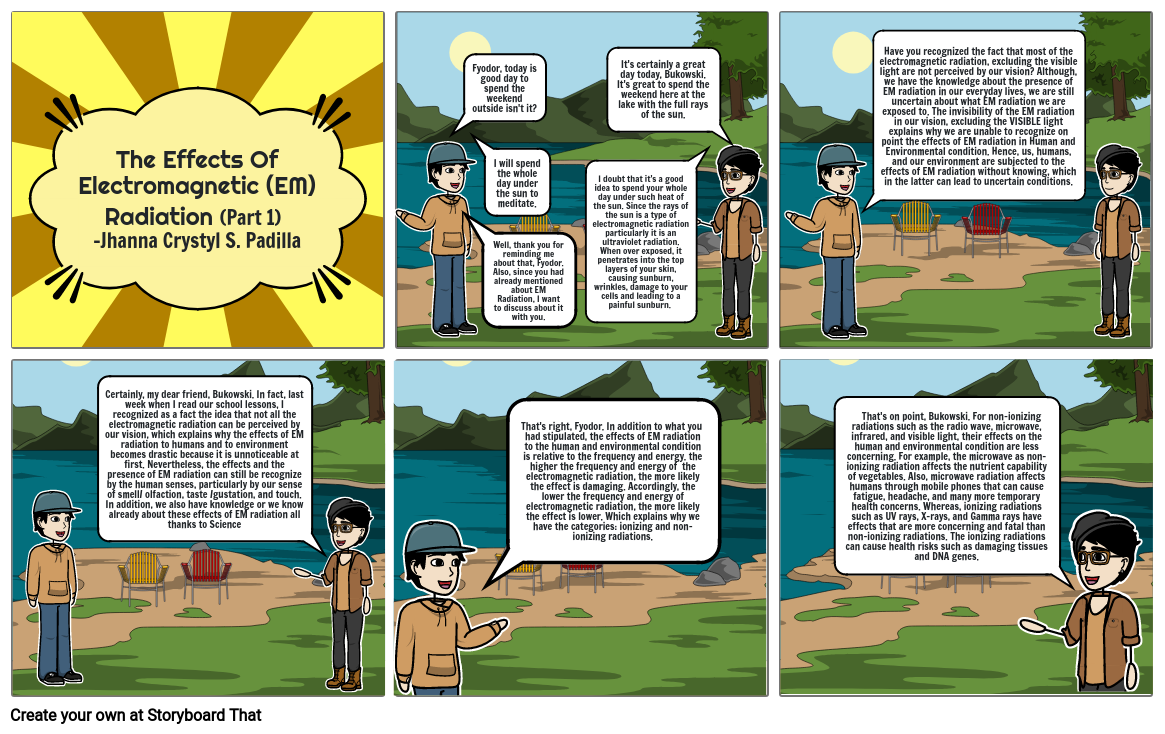SCIENCEQ2M3

Storyboard Text
- The Effects Of Electromagnetic (EM) Radiation (Part 1) -Jhanna Crystyl S. Padilla
- Fyodor, today is good day to spend the weekend outside isn't it?
- Well, thank you for reminding me about that, Fyodor. Also, since you had already mentioned about EM Radiation, I want to discuss about it with you.
- I will spend the whole day under the sun to meditate.
- I doubt that it's a good idea to spend your whole day under such heat of the sun. Since the rays of the sun is a type of electromagnetic radiation particularly it is an ultraviolet radiation. When over exposed, it penetrates into the top layers of your skin, causing sunburn, wrinkles, damage to your cells and leading to a painful sunburn.
- It's certainly a great day today, Bukowski. It's great to spend the weekend here at the lake with the full rays of the sun.
- Have you recognized the fact that most of the electromagnetic radiation, excluding the visible light are not perceived by our vision? Although, we have the knowledge about the presence of EM radiation in our everyday lives, we are still uncertain about what EM radiation we are exposed to. The invisibility of the EM radiation in our vision, excluding the VISIBLE light explains why we are unable to recognize on point the effects of EM radiation in Human and Environmental condition. Hence, us, humans, and our environment are subjected to the effects of EM radiation without knowing, which in the latter can lead to uncertain conditions.
- Certainly, my dear friend, Bukowski. In fact, last week when I read our school lessons, I recognized as a fact the idea that not all the electromagnetic radiation can be perceived by our vision, which explains why the effects of EM radiation to humans and to environment becomes drastic because it is unnoticeable at first. Nevertheless, the effects and the presence of EM radiation can still be recognize by the human senses, particularly by our sense of smell/ olfaction, taste /gustation, and touch. In addition, we also have knowledge or we know already about these effects of EM radiation all thanks to Science
- That's right, Fyodor. In addition to what you had stipulated, the effects of EM radiation to the human and environmental condition is relative to the frequency and energy. the higher the frequency and energy of the electromagnetic radiation, the more likely the effect is damaging. Accordingly, the lower the frequency and energy of electromagnetic radiation, the more likely the effect is lower. Which explains why we have the categories: ionizing and non-ionizing radiations.
- That's on point, Bukowski. For non-ionizing radiations such as the radio wave, microwave, infrared, and visible light, their effects on the human and environmental condition are less concerning. For example, the microwave as non-ionizing radiation affects the nutrient capability of vegetables. Also, microwave radiation affects humans through mobile phones that can cause fatigue, headache, and many more temporary health concerns. Whereas, ionizing radiations such as UV rays, X-rays, and Gamma rays have effects that are more concerning and fatal than non-ionizing radiations. The ionizing radiations can cause health risks such as damaging tissues and DNA genes.
Over 30 Million Storyboards Created
No Downloads, No Credit Card, and No Login Needed to Try!
